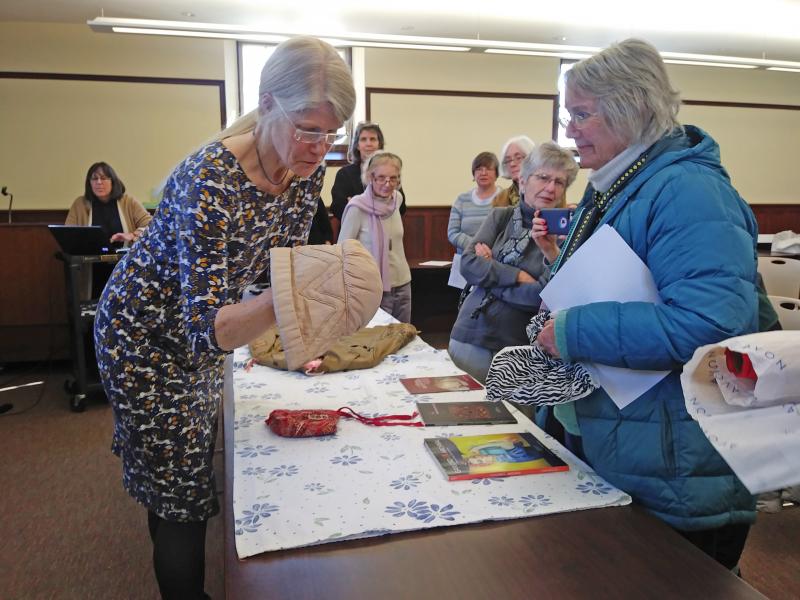'Preserving history': Fabrics worth a thousand words
Textile conservator Kate Tarleton studied an old-fashioned women's bonnet under the lights at the Mattapoisett Library. Found at a flea market, it seemed impossible to decipher when the bonnet was made, or even if it was an authentic piece.
Not for Tarleton though.
"It's nineteenth-century," she said, turning the cap around in her hands. "And probably the first half of the nineteenth century, not the second half."
For Tarleton all that is needed to decipher the origin of a cloth article are a few context clues—stitching, colors and fabric help out.
Tarleton, a resident of Rochester and the owner of ConText, a textile conservation company, identified the age and origin of several pieces brought in for her, and offered advice on conservation, during a lecture on textile conservation at the Mattapoisett Library on March 18.
Alongside the nineteenth-century bonnet, she also advised on the best way to care for an antique Girl Scout shirt, a piece of lace that belonged to librarian Robbin Smith's husband's grandmother, an authentic Chinese silk display brought home from one resident's missionary ancestor and an antique baptism dress.
Her most handy tips?
Owners of cloth pieces such as clothing or quilts should write down and identify the date that the pieces were created, who they belonged to, what they were used for and any pieces of their known history.
After all, Tarleton said, conserving textiles is more about conserving the history and story of the piece than returning it to what some people imagine it would have looked like new.
"That's the difference between a cherished family piece and a quilt you might find at an antiques store in New Bedford," she added. "Those pieces have already lost their stories."
In terms of storage, laundry bags are "the world's biggest no-no," according to Tarleton. Cardboard backings and acidic tissue paper are not much better. Pieces should be stored flat, she emphasized, or at the very least, rolled around a cylinder to ensure that no wrinkles form.
Pieces framed in glass and displayed are at substantial risk of light damage. All forms of light can damage fabric, Tarleton said, but ultraviolet rays are the worst, as the fibers become yellowed and frayed, therefore more easily damaged.
Anything displayed behind a frame, Tarleton added, should be behind glass that blocks ultraviolet rays. If hung up for display, the piece should be hung somewhere where there is no direct sunlight, and rotated every few months.
Don't store fabrics you want to save in a garage or attic either. "Things you want to save should stay in a part of the house that you live in," Tarleton explained. An average temperature of around 70 degrees, with about 50 percent humidity, is ideal. The heat and moisture in places like the garage and basement over the seasons can severely damage fabric fibers.
Oh, and those impossibly white pieces of old clothing or other fabrics that can be found in antique stores? Don't plan on washing anything you want to conserve without very precise input from a textile conservator.
"The dealer [at the antique store] was using a lot of Oxi-Clean," Tarleton said. "But when fibers get dirty, they also get weaker. Washing the weaker fibers can actually make them break down faster."














